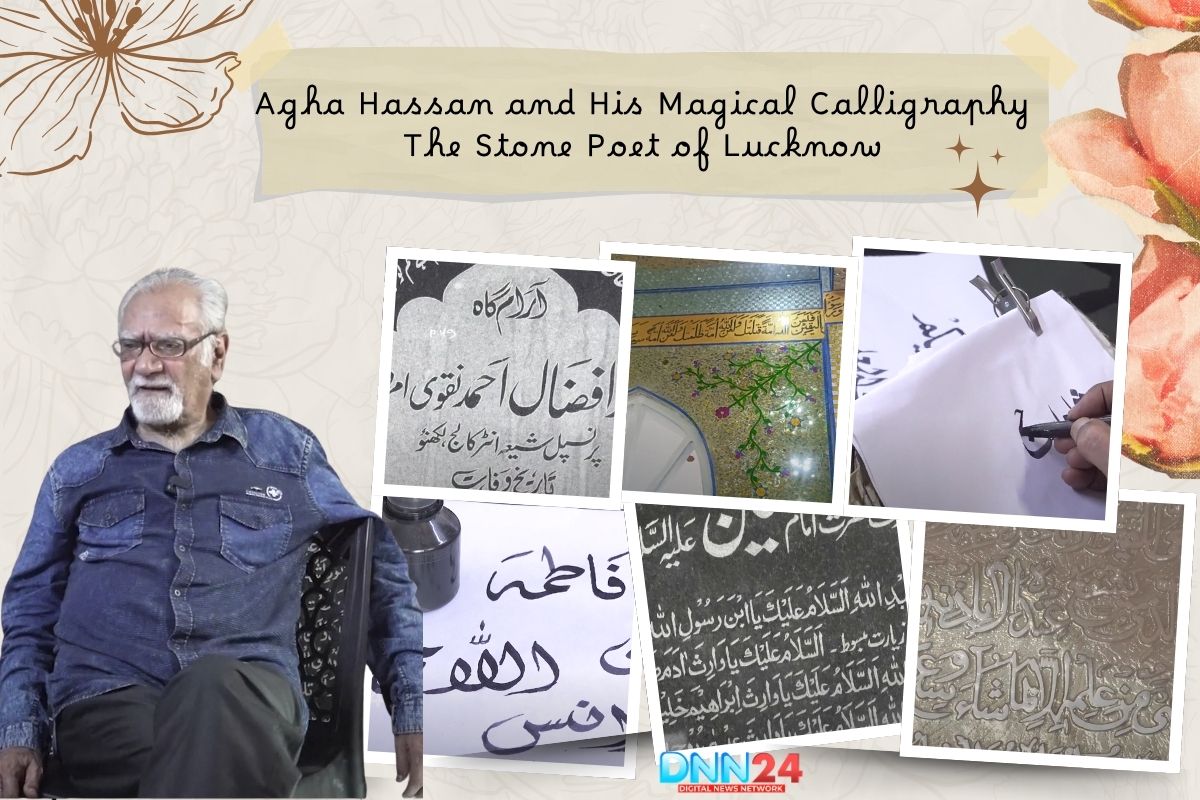Walk through the narrow lanes of Lucknow, and you’ll hear history whispering from every corner. But if you look closely at the walls of imambaras and mosques, you’ll see something magical – beautiful lines carved into stone that seem to breathe life into the very walls. These aren’t just decorative patterns; they’re the soul of a man named Agha Hassan, known as Al-Khattat, whose calligraphy isn’t just writing but pure worship.
And there is a great master-workman in the city of Lucknow, where grace is supplied even to the stones, whose name is resounding throughout the world. His fingers dance on stone as if they’re speaking a divine language. His letters on stone represent carved Urdu words, each with a story, and describe the transfer of the tradition of royal tombs with inscriptions into contemporary times. What makes Agha Hassan special isn’t just his skill – it’s his devotion. Each time he applies his pen, every stroke he takes and every curve he puts his pen to is a faith that turns mundane stones into fantastic canvases of art.
Birth of a Master: Wonder to The World, Childhood to Recognition
At just 12 years old, when other children were busy playing with toys, Agha Hassan was already learning the intricate art of calligraphy. This wasn’t a casual hobby – it was a calling that would define his entire life. Today, he stands as the world’s only calligrapher to have invented nine completely new scripts, including the mesmerising Khat-e-Mahi, where letters flow like swimming fish across the page.
His journey began in the 1960s when he arrived in Lucknow and joined Qaumi Akhbar, the city’s most prominent newspaper at that time. He realised that the local artists were only familiar with Naskh and Nastaliq scripts—the beginnings of Urdu and Arabic writing. But Agha Hassan was different. He possessed knowledge of various scripts that others hadn’t even heard of.
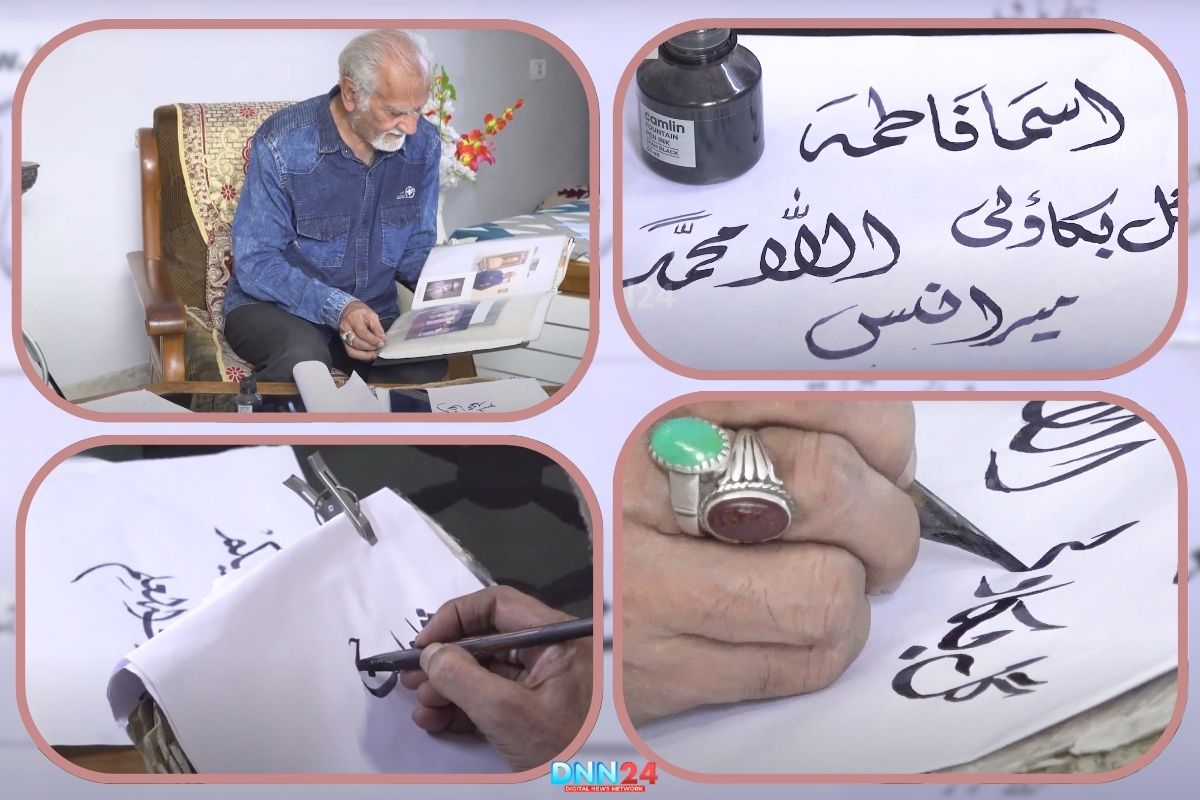
That was his commercial start, and he had to make money so that he could feed his children. It had evolved into an artistic empire that would later attract the attention of wealthy individuals from around the world, including royalty, celebrities, and art enthusiasts like them. His dedication wasn’t just professional – it was personal, spiritual, and completely transformative.
Calligraphy: The Magical Scripts: Nine New Things That Transformed Calligraphy Forever.
Agha Hassan didn’t just master existing calligraphy styles – he created entirely new ones that left the art world stunned. Among his nine created scripts is the well-known Khat-e-Mahi, in which letters move like fish through the water of the page, and Khat-e-Gulzar, where flowers and leaves begin to flower in the words themselves. Every script is used to narrate a different story for a specific purpose.
These scripts are so complex. He initially inserts a helping line of text and then meticulously adds flowers and leaves to each letter, creating a blossoming garden effect, as seen in Khat-e-Gulzar. The Khat-e-Mahi has such precision that the audience tends to perceive the letters as real, elementary fish swimming in the water.
These aren’t just artistic experiments – they’re revolutionary contributions to the world of calligraphy that showcase how tradition can evolve while maintaining its sacred essence. When people see his work, they don’t just read words; they experience art that bridges the gap between the divine and the earthly, between ancient traditions and modern innovation.
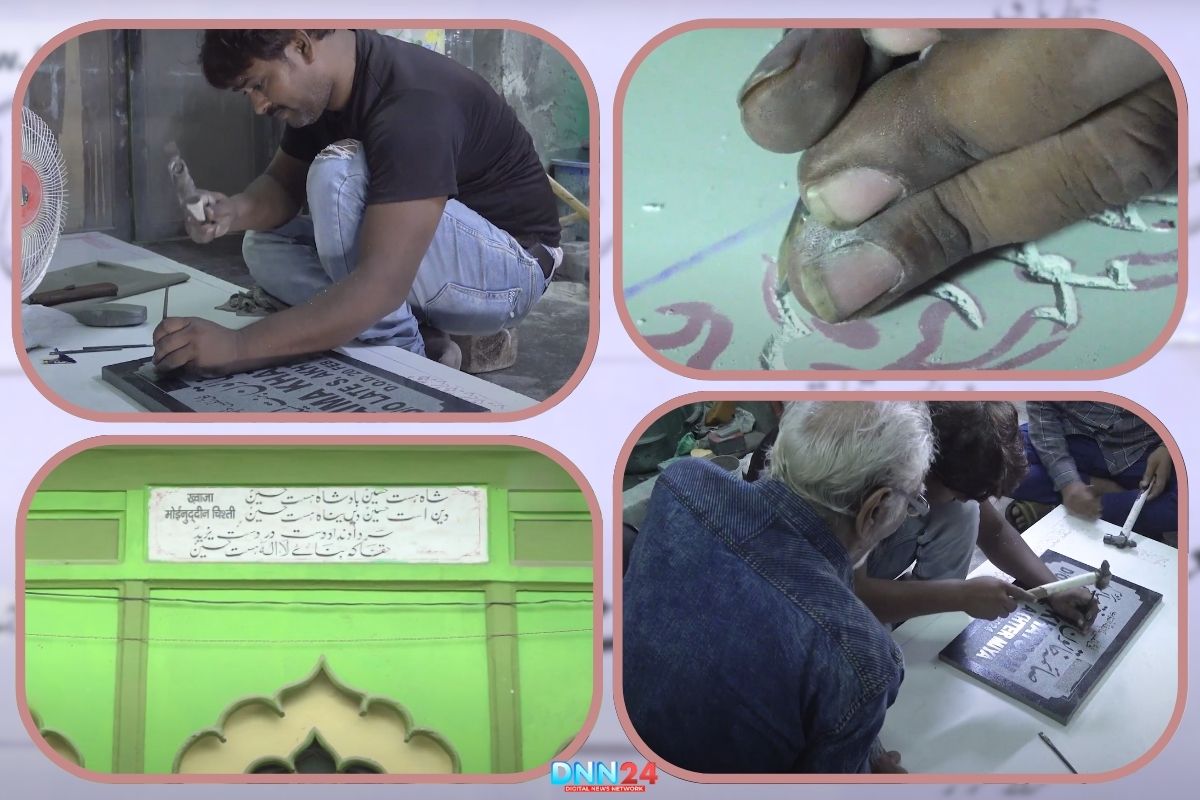
Stone Poetry: Medina and Bollywood: The Global Role of Stone Poetry
Agha Hassan’s reputation spread far beyond Lucknow’s boundaries. He worked on honing his trade at Medina, the holy city, before the Sheraton Hotel dared him to come up with something that had not been seen before in the world. His response was a masterpiece—a complete architectural portrait of the hotel, created entirely through calligraphic lines, which still graces the hotel’s lobby today, adding to its prestige.
However, his most unimaginable ability is his ability to create food grain art, which silenced the Saudi royals. When Prince Abdul Majeed saw King Abdulaziz’s portrait, made entirely from rice and lentil grains, he invited Agha Hassan to the palace and declared, “This skill is a gift from Allah.”
Amitabh Bachchan and Subrata Roy Sahara are only a couple of names in the long list of celebrities who have been stunned by his talent in creating Montages of them using grains only. When Big B saw his rice-grain portrait, he exclaimed, “This looks more stylish than me!” These aren’t just artistic achievements – they’re cultural bridges that connect different worlds through the universal language of art and creativity.
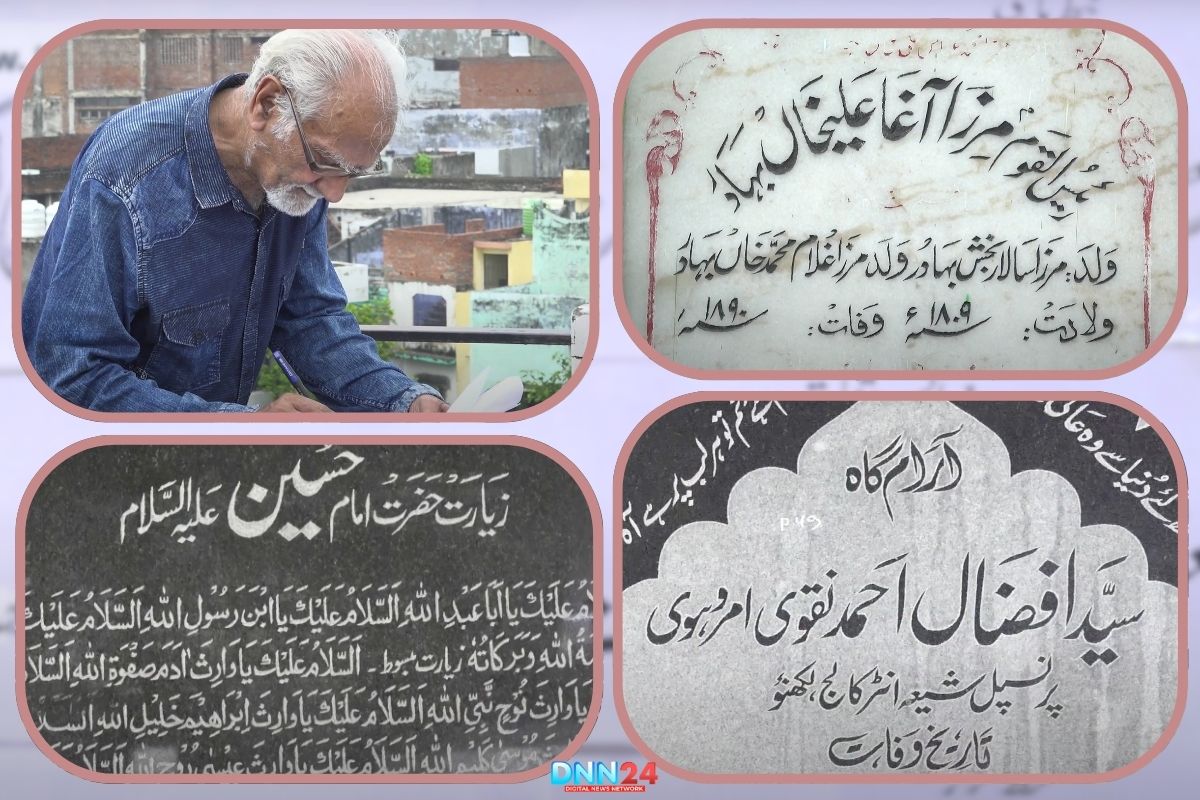
The Magical Moment: Where Headlines Wrote the History
The assassination of President Kennedy in 1963 caused a crisis at Qaumi Akhbar newspaper. The normal calligrapher was absent, and no one else was able to write the headlines in the traditional style. That night, Agha Hassan stepped up and wrote the headlines in a completely different script, Khat-e-Riqa, which gave the newspaper an Arabic appearance instead of its usual Urdu look.
The following morning, when editor Hadullah Ansari entered the workplace, he thought he was gazing at an Arabic newspaper rather than his own Urdu publication. This incited his surprise to the extent that he had to start searching for the person who had brought such a radical transformation.
When he discovered it was Agha Hassan, he was so impressed that he compiled all the headlines into a file and noted that such scripts were perfectly suitable for major international news. This incident marked a turning point in Urdu journalism, establishing Agha Hassan as an innovator who could adapt traditional art forms to modern needs while maintaining their authenticity and power.
The 42-Foot Miracle: The Meeting of Art and Piety
One of Agha Hassan’s most spectacular achievements is a 42-foot-long Quranic verse carved into stone at a Lucknow imambara. This isn’t just calligraphy – it’s architectural art that makes visitors bow their heads in respect. This precision was necessary to fulfil the project. Therefore, he needed to establish specific measurements and employ screen printing techniques to ensure the ideal ratios on the large surface of the stone.
When Maulana Kalim Sadiq, an international Islamic scholar, saw the space and told Agha Hassan he had been waiting ten years for the right person to do this work, the master calligrapher knew this was his moment. He placed the entire stone surface at his office, measured it to extreme accuracy, and created stencils that ensured every letter was proportionate.
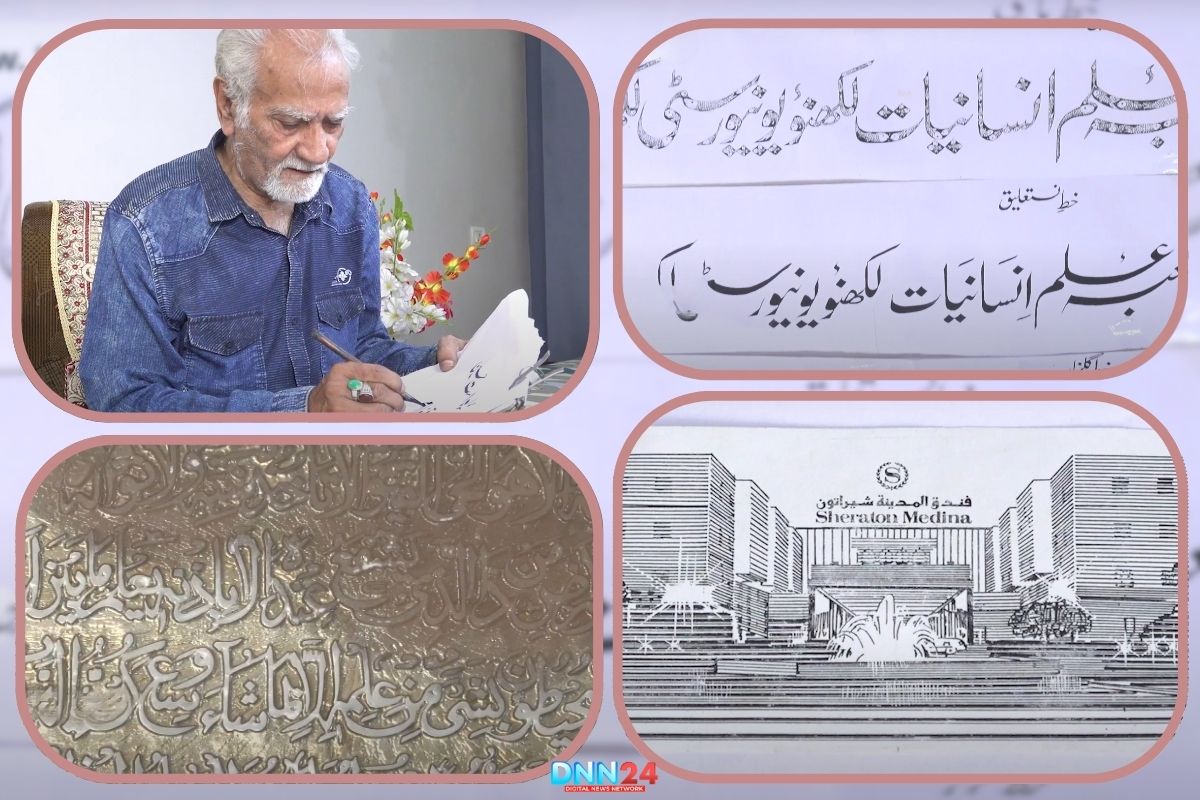
The work is a masterpiece that can be appreciated even when read at a distance, yet still maintains the delicacy of the classical Islamic calligraphy. This piece is a remarkable example of a spiritual commitment and an artistic masterpiece, indicating that true art serves a greater purpose.
The Future of Stone Poetry: Maintaining the Pagan Art in an Internet World
When a Pakistani calligrapher once said that computers had made hand-written calligraphy obsolete, Agha Hassan replied with wisdom that defines his entire philosophy: “Machines run on brains, but skill comes from the heart.” This was true as he continued to command jobs that computers can never do – family trees, ceremony inscriptions, and artistic work that can only be created by humans.
At his advanced age, Agha Hassan’s hands still move with steady precision, his eyes still see the subtle curves that make each letter perfect, and his heart still beats with the same passion he felt as a 12-year-old boy discovering the magic of calligraphy. He considers that the machine could replace commercial writing, but the real artistic calligraphy would always require human hands, human hearts, and human souls.
His creation still inspires new generations of artists who realise that not everything can be digitised, mechanised, or automated; it has to be felt, experienced, and created through the combination of artist and art, which cannot be replaced. That is why his name will live as long as technological innovations, being immortalised in the stones of Lucknow and in the hearts of the people who will recognise what is art.
Today, as you walk through Lucknow’s historic streets, take a moment to read the words carved in stone. You may hear the voice of Agha Hassan’s pen, reminding us that true art never dies – it only transforms, endures, and continues to inspire.
Also Read: Paandan: The Soul of Lucknow — From Nawabi Grace to Bridal Legacy
You can connect with DNN24 on Facebook, Twitter, and Instagram and subscribe to our YouTube channel.

